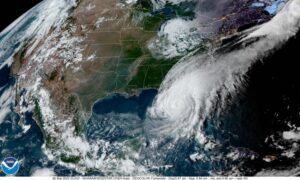 When we need to get out of harms way. Hurricane Ian’s insured losses continue to mount. Estimated losses are ranged from 53 to 74 billion dollars from Florida to the Carolinas. The modeling firm, RMS *, estimates that the damage will be very close to $67 billion in insured losses. These figures will rank Hurricane Ian as the All-Time costliest storms to hit Florida and place it 2nd only to Hurricane Katrina nationally as pertaining to insured losses. Densely populated areas such as Naples, Ft. Myers, and the barrier Island Sanibel were devastated and the death toll has already surpassed 100 souls**.
When we need to get out of harms way. Hurricane Ian’s insured losses continue to mount. Estimated losses are ranged from 53 to 74 billion dollars from Florida to the Carolinas. The modeling firm, RMS *, estimates that the damage will be very close to $67 billion in insured losses. These figures will rank Hurricane Ian as the All-Time costliest storms to hit Florida and place it 2nd only to Hurricane Katrina nationally as pertaining to insured losses. Densely populated areas such as Naples, Ft. Myers, and the barrier Island Sanibel were devastated and the death toll has already surpassed 100 souls**.
As the storm approached, many Floridians, not on the west coast, slowly started breathing a sigh of relief as the storm did not seem to be in the path of their assets and, more importantly, their families. Only those familiar with the unpredictable nature of these storms were not ready to let their guards down. We watched very closely as the storm developed and spaghetti models changed on the National Hurricane Center website. For those in the aviation world, frequent visits to the aviation weather website became an hourly process. Pilots and others in the aviation business rely on this site for the data it offers regarding wind speeds, wind patterns, rain, pressure trends, and other such important forecast tools. I note that early on the aviation weather forecasted a track closer to where the storm finally arrived further south than was being projected by national and local news stations. It was very accurate in its forecast as it often is. This data put us on high alert, and we shared our concerns with operators and clients looking for more information.
Many air charter operators are responsible for not only keeping their clients safe during flights, but also protecting their own and their clients managed aviation assets. Insurance policies often offer some level of reimbursement to move the aircraft out of the predicted path. Simultaneously, clients wishing to relocate during the storm often turn to companies like ours to help them find flights departing the area. Recognizing this situation as being mutually beneficial, we match our clients with operators looking to move their planes quickly prior to the arrival of the storm. Unfortunately traditional brokers look at this as an opportunity to price gouge, taking advantage of clients fears by abusively marking up the flights. We disagree with this practice and do our best to match our clients with the need to get to a safer location with the operators desiring to do the same. Pricing will likely be a bit higher than normal as these are often last minute arrangements and take considerable effort to accomplish, however, the main objective is always the same: help clients and assets to get to a safe location as quickly as possible, and most importantly, out of harms way.
Our personal experience with this storm was illuminating. With our knowledge of the weather data we have access to, we felt we were out of harms way with this storm. We felt comfortable our residence was secure and ready, but our personal plane was in for service and would be left exposed on the tarmac at North Perry Airport. Thankfully we were able to relocate it to our hangar only a few short hours before a horrific tornado spawned by one of Hurricane Ian’s outer bands set down on the airport and wreaked havoc on over 35 unprotected planes. This redefined our definition of safe and secure. We now plan to increase our efforts in storm preparedness for our clients and supporting air charter operators. You will soon see a new page on emptylegs.net dedicated to storm and other natural disaster tools where we will share bad weather data as it approaches. Of course, we always recommend following the guidelines from official channels.
Whether you are an air charter operator or a current or potential private air travel client, feel free to contact us now with your evacuation requests, concerns, and questions about future storm or disaster preparedness. Our email, info@emptylegs.net, is the best way to request to be added to our evacuation plan until our emergency page is live.
We publish our blog weekly every Tuesday morning and our next one will look to clarify some of the differences between FAA Part 135, 121, and 91 for the private air charter clients.
Until then, Be Social, Fly Private! Sign Up Today! Follow us on Instagram Follow us on Facebook
*RMS, a Moody’s Analytics Company, Newark, CA – October 7, 2022
**Associated Press, Stephen Smith, October 6th, 2022

 Hurricane Ian will go down in history as one of the worst storms to impact the state of Florida in decades. It devastated the west coast of Florida with near Category 5 winds, torrential and unrelenting rain, plus a whopping 12+ ft storm surge. Like its predecessor, Hurricane Andrew, it caused death and destruction in the billions of dollars. 30 years ago, Hurricane Andrew caused 50 billion in damage, destroyed 60,000 homes, and left 170,000 people homeless. We haven’t had enough time to tally the pain caused by Hurricane Ian, but I’m sure the numbers will dwarf those of Andrew. Most of the areas hit were swamps and mangroves back in the early 1900s until men like Carl Fisher and Henry Flagler etched out their respective fortunes turning these same natural landscapes into concrete and coral stone. We no longer have the protection from mother nature’s palm trees, everglades, and mangroves to protect us. Although newer multi-million dollar homes and buildings are engineered with strength to endure these natural disasters, they seem not as well suited for battle as these weather events get more and more powerful with our ever changing climate and environment.
Hurricane Ian will go down in history as one of the worst storms to impact the state of Florida in decades. It devastated the west coast of Florida with near Category 5 winds, torrential and unrelenting rain, plus a whopping 12+ ft storm surge. Like its predecessor, Hurricane Andrew, it caused death and destruction in the billions of dollars. 30 years ago, Hurricane Andrew caused 50 billion in damage, destroyed 60,000 homes, and left 170,000 people homeless. We haven’t had enough time to tally the pain caused by Hurricane Ian, but I’m sure the numbers will dwarf those of Andrew. Most of the areas hit were swamps and mangroves back in the early 1900s until men like Carl Fisher and Henry Flagler etched out their respective fortunes turning these same natural landscapes into concrete and coral stone. We no longer have the protection from mother nature’s palm trees, everglades, and mangroves to protect us. Although newer multi-million dollar homes and buildings are engineered with strength to endure these natural disasters, they seem not as well suited for battle as these weather events get more and more powerful with our ever changing climate and environment.